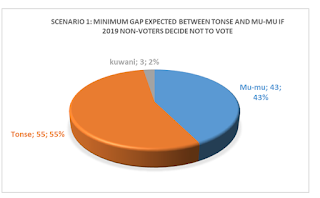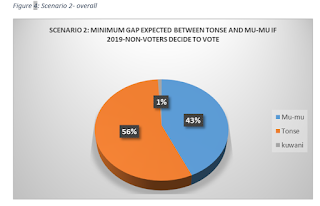Malawi Fresh Presidential Elections probable outcomes in two axioms and lemmas
Mfumusaka (www.mfumusaka.blogspot.com)
Introduction
·
· Voter behaviour by
Malawians is an interesting and complex phenomenon governed by a train of
factors, some influential and others determinantal, with others as important in
moderating the final result. An attempt to summarize these processes can be
appreciated in Matchaya (2010) in the African Journal of Political Science and
International relations that focuses on Africa political events and available
at http://citeseerx.ist.psu.edu/viewdoc/download?doi=10.1.1.902.7977&rep=rep1&type=pdf
·
·
So, the fact that voters behaviour is influenced by many factors is
something this analyst is aware of.
·
·
·
Thus, considering all these factors and the lag
with which they change, the results in this year’s elections are likely to be a
mirror image of 2014 and 2019 results but altered to the extent of
the reconfiguration at present.
·
·
·
· As an
example, a combination of UDF and DPP obtained 15% from the centre,
amounting to ~460,000 votes in 2019 ; But a combination of MCP and UTM obtained
22% in the South and 19% in the East amounting to Tonse getting ~470k
votes from East and South combined.
·
·
· Whether the 2019
votes were all untrue owing to rigging is important and is accounted for in scenario
three below. But in general if there was rigging in 2019, the key beneficiaries
were not Tonse alliance, and so, it would mean their votes were understated, in
which case, correcting for rigging puts them in even a stronger position.
·
· Tonse thus has gone
into this 2020 FPE with a 12 percent point lead against the UDF/DPP
alliance of Muluzi and Mutharika (Mu-mu) alliance.
·
· Assuming that rigging
is minimized, it is hence probable for Tonse alliance to win.
·
· The three scenarios
below predict a Tonse win with at least 55% of the votes. The DPP will at best
get 43%
Scenario 1: assume 2019 elections were
not rigged
Fact: The registered voters in this election are the same as we had in
2019 generally
·
· Axiom 1: The voting
pattern in 2020 can only change against the alliances if any of the alliances
either by the manner of constitution or by the manner in which they have
campaigned, is such that they have been outclassed.
·
o Insight A1: The Alliances have
energized their bases and no outright loser in their base may be noted a
priori.
·
o Lemma 1: Chilimas voters
have followed him, UDF’s voters have followed him. However given everything,
DPP did not campaign heavily with parts of them a bit unhappy and less visible.
Mia on the Tonse side took the Tonse changes generously and campaigned very
strongly.
·
·
· Assumption 1: Let us assume that
the turn out rates from each region (North, Centre, South, and East) remain
more or less the same as in 2019 (and there are no reasons to be pessimist in a
highly contested election).
·
·
· Prediction 1: Then the voting
patterns are likely to remain as in 2019 and if they tilt, it will eb against
Mu-mu alliance for the detail in Insight A1. Then
·
o the alliances
will amass votes equivalent to their 2019 sums with slight
variations. Tonse in that case will win with close to just under
3 million votes while DPP will accumulate around 2.2 million votes
at the very maximum.
Figure 1: Prediction 1:
Figure 2: Prediction 1 (shares)
In terms of shares, this will translate to Tonse (55%), Mu-mu (43%) and
Kuwani will be under 2%
Scenario 2:
Patterns follow 2019 but more voters energized
Fact: This election has been resoundingly more contested than the 2019
one for several reasons.
· Axiom 2: More voters
will show up in 2020 because of the sharpness of messages on campaign trail and
real possibilities of a win on each side. .
o Insight A2: The Alliances have
energized their bases and the 800k registered voters who did not vote in 2019
at the Center may now vote; the 200k non-voters, etc would vote
Table 1: Cast rates and possible new voters
|
Center
|
North
|
South
|
East
|
|
|
Total
|
2920423
|
929974
|
1880200
|
1128973
|
|
Non-voters 2019
|
795011
|
200609
|
459412
|
298555
|
|
Cast
|
2125412
|
729365
|
1420788
|
830418
|
|
Cast Rates
|
0,727775
|
0,784285
|
0,755658
|
0,735552
|
|
New Voters From Non-voters
|
578589
|
157334
|
347158
|
219602
|
o Insight A2.1: The patterns of
new voter influx in each region will mimic the cast rates of 2019.
o Lemma2: In any case if
the rates are to be scaled down, the ratios across the regions are likely to
remain the same and if they were to change, hey would go to a more energized
base which is the Centre, North, and East
· Assumption 2: Let us assume that
the split in votes of the new entrants (who were non-voters in 2019) from each
region, to the Tonse alliance and Mu-mu alliance follows the same patterns with
which each region split its votes to these parties in 2019, then we know that
of the new votes the distribution will follow the pattern below:
|
Center
|
North
|
South
|
East
|
|
|
New voters from non-voters
|
578589
|
157334
|
347158
|
219602
|
|
%
|
83
|
78
|
22
|
19
|
|
Tonse
|
477800
|
122318
|
77548,56
|
42450,3
|
|
Mu-Mu
|
86913
|
31380,44
|
261155
|
169861
|
|
%
|
15
|
20
|
75
|
77
|
Thus, from Table 2, of the ~800k voters who did not vote in
2019 at the centre, about 600k may vote in 2019. Of those ~600k new voters at
the centre, Tonse would get 83% (that’s what they got the previous time), which
is about 500k, leaving 86k for Mu-mu. Similarly, in the South, of the 350k new
voters, Mumu will get 75% (261,000) in line with what they got in 2019. In the
East they will get 77% of the 219000 ie 170,000 while Tonse in each case will
get 77000(south), and 42000(east) of the new voters.
· Prediction 2: Given the above
and Axiom A2., the total votes for each alliance will be as summarized
in Figure 3
o The alliances will
amass votes equivalent to their 2019 sums plus the additional energized voters
from their respective regions split according to the known ratios of
2019. Tonse in that case will win with close to just over
3.5 million votes while DPP will accumulate around 2.7 million votes
at the very maximum.
Figure 3 : Scenario 2
In the final analysis, the ratios nationally will be as
in Figure 4 ie Tonse alliance will win.
Figure 4: Scenario 2- overall
Scenario 3:
Assume there was rigging in 2019
Assumption 3: In 2020 the chances of rigging are low owing to reconstituted MEC
and other efforts on the side of the opposition, and hence counting may be
closer to the truth.
· If this is the case
then it can only be at the disadvantage of Mu-Mu as they were in that case the
beneficiary of 2019 rigging.
· Lemma 3: Yes UDF suffered from
rigging but as the rigger would have been DPP, a scenario of no rigging will
simply make the votes that DPP took from UDF, legitimate, but won’t add to the
sum of DPP plus UDF.
· However, where
rigging is checked, then DPP gives up what it stole from MCP and UTM, to the
Tonse alliance.
· Prediction 3: This increases
Tonse alliance shares from 56% to further, to the extent that DPP had cheated
them in 2019. This may mean that a 60% vs 39% for Tonse and Mumu alliances in
that order is not a far-fetched probability.
Ø In the end, the gap
between Tonse and Mu-mu alliance will be at least 500k to 1,2 million votes
with Tonse holding the upper hand
Conclusion
· Under no- to moderate
rigging, there is no feasible way for Mu-mu alliance to win these elections.
· Chakwera and Chilima
will be Malawi’s leaders (President and Vice President) from tomorrow evening .





Comments
Post a Comment